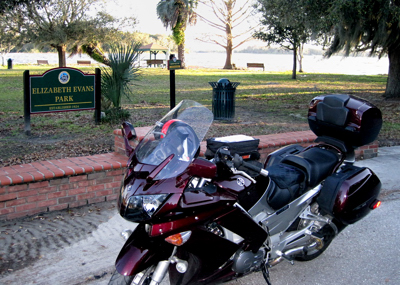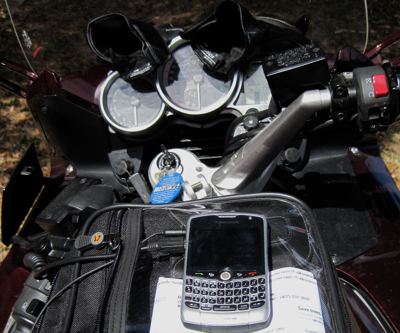|
|
Click Here to Add to Your Favorites | |||||
|
|
||||||
|
Travel Information and Arrangements |
Preparations: Luggage, Travel Clothing, Gear, Gifts,... |
Tips: Photography, Packing,... |
||||
Shop OnLine - SAVING Time + Gas = Money
1 | Getting There | by MOTORCYCLE Got to Go, Somewhere!Have you had one of those weeks that was so stressful you just had to "get out of Dodge" to clear your head? When I did, my way to deal with it was to make an adventure out of it. So I did some internet research for a place to go & route to take, sites to see and a place to stay. I then packed my saddle bags for an overnight and took off on my motorcycle. This was, in fact, my first solo motorcycle trip longer than an hour from home (with no support car to carry additional stuff). Trying to pack clothes and gear for a variety of weather conditions, dinner destinations and outdoor activities, was amazingly tough considering the limited room in motorcycle bags. For you "Easy Rider/Hell's Angels" types who are used to traveling around the country regularly on long trips, you are probably laughing right about now. This page is for the novice rider who has yet to experience a weekend on the open
road with two wheels. I would like to share with you what I learned on this trip. Finding a RouteAs you may have already discovered, there are roads and there are ROADS, those highways that just seem to be designed with the motorcyclist in mind: winding, well-paved roads through great scenery, that are much more fun to ride than those utilitarian, crowded, hectic interstates. How do you find these gems? Here are a couple of really useful sites for finding routes that others have ridden before you:
Want to plan your trip with biker-friendly establishments along the route?
Other resources for planning a motorcycle trip: Motorcycle Travel
Maps & DirectionsAfter downloading your maps from the sites above, how are you going to read them while riding? Obviously, reading while rolling is impossible but you could fold a map or set of directions into the top of a magnetic tank bag to read at stops.
One article I read suggested writing turns on your windshield with a grease pencil (a.k.a. china marker), which will wipe off easily. My lifesaver when lost is using the GPS software in my Blackberry (Verizon
Navigator). Whether you already have a motorcycle GPS system Remember to look for small buds so they won't fall out of your ear when you pull your helmet on. I also found that I preferred to wear only one of the two earphones. If I wore both, they muffled the outside sound and preventing me from hearing cars around me. Being able to hear "Michelle" (the voice of the GPS) giving turn-by-turn directions as you need them helps you to confidently and safely navigate to any destination while on your bike, without having to memorize or read directions. The search function in the GPS program also helps you to search for destinations and services from your current GPS location which is also extremely helpful. Remember those days when you had to locate a telephone booth with a phone book? How did I keep my Blackberry charged while using it on the bike? If your bike has a cigarette-lighter style outlet, plug into it with the car-charger for your cell phone and keep it plugged in during your trip (I understand, though, that this will shorten the life of your phone's battery). I secured the cell phone by wedging it into the map pocket of my tank bag, partially zipping closed the compartment to keep the charger cord from pulling my phone out of the bag.
Last tip: I had never worn my prescription glasses while riding my motorcycle (I have good distance vision) until I started using my GPS while riding. If you have progressive bifocals, they work great when having to switch from reading your GPS or map in your tank bag to focusing on the road. Don't forget, though, to take your glasses off before you take your full face helmet off! *Note of caution: I recently used my GPS as pictured above on a particularly sunny and hot day. While mid-route my phone died leaving me directionless. When I took the "dead" phone out of the bag, the battery on the bottom was particularly hot so I suspect that it overheated in the "hot-house" portion of my tank bag. On hot sunny days you may have to protect it from the sun and heat by slipping it into the belly of the bag. You won't be able to read turn directions but you will still be able to hear them thru your earpiece. As a backup for your trip you may want to print out turn-by-turn directions thru Mapquest.
Not only did I lose my GPS when the phone overheated, but I also lost my ability to make phone calls. Now try
finding a phone booth! It turned out the phone did not sustain any permanent damage and started functioning as soon
as it cooled off, a few hours later. Check the WeatherNot only do you need to know what temperatures you need clothes for (both on and off
the bike), but also the chances for rain (take Motorcycle Rain Gear What I didn't anticipate was how windy it was going to be. I learned just how difficult riding a bike through wind can be as I had to fight from being pushed out of my lane by sudden crosswind gusts. The wind was so strong that highway signs were twisting back and forth, and I found that I had to slow down on curves because I couldn't lean my bike into the turn against these heavy crosswinds. For LodgingWant something relaxing and private? Clothing TipsThe toughest part of motorcycle travel is downsizing what you can pack because of the space and weight limits of your bike's bags. I packed clothes and shoes into my side hard cases and left the gear for the center bag (rain gear and a bag for "stuff": my Kindle with clip-on light, charger & batteries, any papers like maps, reservations, etc). The beauty of the Kindle reader is that it is lighter and smaller than even one hardback book, yet can hold 1500 books. Remember to keep the weight of items in your center bag as light as possible, pack heavy items in the bottom of the side bags, and try to balance the weight on the sides. The trick to packing clothes is to get by with the least weight and bulk possible. Lightweight hiking
pants Altrec Outdoors - Mens Travel/Trek Pants If you roll up each "outfit" (including underwear) into a tight roll, they will pack well into your bag.
You'll probably want to bring a dressier pair of hiking pants for dinner along with a nicer shirt. A Patagonia friction belt If you are going to be gone 3 days or more, it is possible to get by with only 1-2 pr. of wool socks Altrec Outdoors - Smartwool Men's Hiking Light Crew Socks and a couple of shirts (perhaps a long and short sleeved) which will greatly reduce the number of items you need to take since wool (especially Merino wool) can be worn multiple days without retaining odor. The shirts are designed for casual /active wear. The long sleeved merino shirt is also perfect as an extra layer for warmth while riding. It is now possible to get Merino wool underwear (for men & women): Altrec Outdoors - Icebreaker Wool and other active Briefs You might want to bring a swimsuit, a pair of shorts for warmer weather, and perhaps something to sleep in. The biggest problem is shoes, especially for guys. If you can get by with your boots for dinner, that saves bringing an extra pair of "dress" shoes. If you bring shorts you may want to bring a pair of running shoes which will take up a lot of space; flip-flops would be less bulky. Toiletries: Go light! Bring travel-sized (TS) toothpaste, shaving gel and only one TS shampoo and conditioner; as you know, most hotels will provide these as well as a hair dryer. Pack it into a toiletry bag that keeps everything together. "Dress" Jacket: for cooler weather the perfect jacket for a trip like this is a micro-fiber
jacket. It is a lightweight jacket for cool weather that is dressy casual. It can be turned inside-out and rolled
into a tight log for packing without wrinkling. An example of a coat like this would be the Executive 2-Button Sueded Microfiber Sportcoat from Jos. A. Bank Misc. Motorcycle Travel Books and Gear
Motorcycle Accessories Motorcycle Boots men Other Useful Items
Both of these items are very small and light, perfect for bike travel. The flashlight works on 3
AAA batteries and being an LED, those batteries will last a long time. next page: 2 | WHERE TO STAY (lodging) | ||
HOME Research - Plan Trip Find a Travel Destination or Activities YOU are SPECIAL! Students Family LUXURY! Travel Information Travel Arrangements 1 | GETTING THERE 2 | WHERE TO STAY 3 | GROUND TRANSPORT, RENTAL CARS 5 | WHAT TO DO WHILE THERE ---Stuff --- To Bring, To Do GO! The Day of Travel GO! THE DAY OF TRAVEL - Broadband Version AFTER the Trip - Memories CONTACT TRAVELUPLAN Important Disclaimer Privacy Statement Photography Tips Site Map ©2008-2013 Think Gig, LLC |




